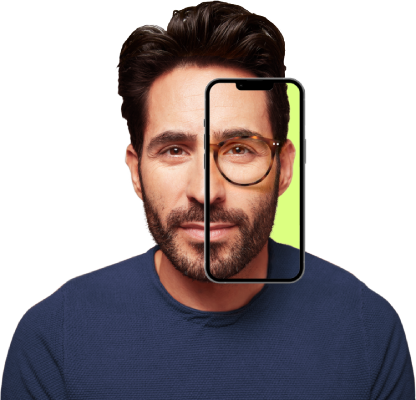
Our new virtual try-on tool lets you try on our latest styles anytime, anywhere!
Everything you need to know to take care of your eyes — for life.
“On no! I drifted off in contacts!” We’ve all been there. Here’s exactly what to do next to protect your eye health.

Your corneas are like fine wine or soccer cleats: They need to breathe. And therein lies the problem with falling asleep in contacts.
All tissues in the body need oxygen to survive. Your corneas, or the transparent front surfaces of the eye, are no exception. They have to draw oxygen from their environment, says Cristen Adams, O.D., a primary care optometrist at America’s Best Contacts and Eyeglasses in Pittsburg, Calif.
During the day, says Dr. Adams, when your eyes are open, they pull oxygen right out of the air. But at night, they have to obtain it from the blood vessels in your eyelids—a more difficult task.
“When you close your eyes, the cornea only gets about one-third of the oxygen it gets when the lids are open,” says Dr. Adams.
Put a contact between the cornea and your eyelid and, well, you see the issue. The result is oxygen deprivation, which can lead to a host of problems.
Some contacts, known as extended-wear contacts, are approved by the Food and Drug Administration for continuous wear — including overnight. They’re made from a semipermeable material called silicone hydrogel and come in two types: 7- and 30-day.
But most contacts aren’t permeable and are therefore only meant for daily use. (Learn more about the differences between these two types of lenses by reading Dailies vs. Monthlies: Which Contact Lens is Best for You? here.)
Did you know that contact lens prescriptions need to be renewed every year? Click to find an exam time that fits your schedule.
If you deprive your cornea of oxygen, it may swell, which can cause irritation, blurred vision, or an infection. Do it repeatedly and you’ll reduce the cornea’s ability to regenerate cells on its outer edges, which are especially adept at protecting your eyes from invaders.
“You’re increasing the ability of bacteria to get into the deeper layers of the eye and cause infections,” says Dr. Adams.
In fact, according to a report by the Centers for Disease Control and Prevention, sleeping in contacts lenses increases the risk of eye infections by six to eight times. These infections may result in corneal damage or even permanent vision loss. Some require surgery to treat.
But oxygen deprivation isn’t the only risk. “Lenses that have not been taken out and cleaned have the potential to accumulate debris,” Dr. Adams says. “This can cause the front surface of the eye to mount an immune response, in addition to the bacterial infection.”
Normally, the eye’s immune system plays a protective role. But when a buildup of debris plus an underlying infection are in the mix, all bets are off, says Dr. Adams.
“The immune system doesn’t recognize the irritant, and sometimes it doesn’t do a great job of regulating its response. It can mount an adverse reaction, such as damaging the surrounding tissue, that’s not in proportion to the problem, simply because it’s not happy in its environment,” she explains.
With such a high potential for disaster, Dr. Adams often tells patients wearing extended-wear contact lenses to go ahead and remove them before turning in for the night whenever possible.
And no matter what type of lenses you wear, it’s important to stay on top of the cleansing and care routine outlined by your doctor.

Our new virtual try-on tool lets you try on our latest styles anytime, anywhere!
No matter how careful you are, at some point you’re likely to fall asleep in contacts. Don’t panic—it happens. Instead, do this:
Step 1: After Sleeping in Contacts: Take a Breath
The first step is to let your eyes breathe, which means removing your contacts. But not so fast: You need to do it right. Your eyes make fewer tears when you’re sleeping, says Dr. Adams, so your contacts are likely to be dehydrated—and possibly even stuck to your corneas—when you wake up. Whatever you do, don’t rip them out. You could damage the cornea.
Step 2: After Sleeping in Contacts: Rehydrate
Blinking can get the tears following again, which will eventually separate your contacts from your corneas. Even better: Put a few drops of saline (or eye drops) into your eyes, says Dr. Adams. Blink until the contact feels normal again; this may take a few minutes. You can also close your eyes, put a finger on your eyelid, and feel for movement. Once they’re no longer stuck, it’s safe to remove them.
Step 3: After Sleeping in Contacts: Love Your Glasses
Give your eyes the rest of the day to heal, says Dr. Adams. That means wearing your glasses and using eye drops occasionally to keep them lubricated. You may experience redness, irritation, sensitivity to light, tearing, or blurred vision, says Dr. Adams. If any of these symptoms last more than a day—or are causing you concern—call your eye care professional right away. You may have an infection.
Do you need a new backup pair of eyeglasses? Check out our NEW frame collections!
If you’d like to sleep in your contacts, book a contact lens exam with your eye doctor to find out if you are a candidate for extended-wear lenses. They will fit you with the appropriate lenses for your lifestyle and monitor your eye health over a few weeks and months to make sure they’re safe for you.
Recommended reading: America’s Best Guide to Contact Lenses
Ask an Optometrist: Is it Bad if I Wear My Monthly Contact Lenses More Than 30 Days?
Press play for more ways to protect your eyes and give them the break they deserve: